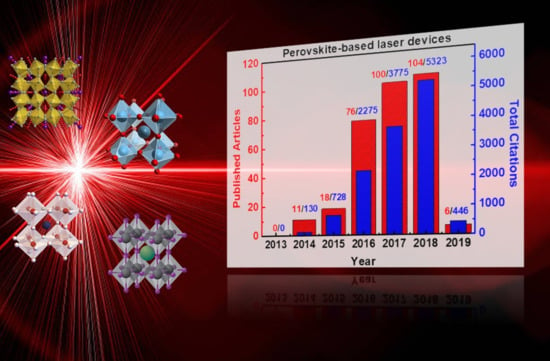Inorganic and Hybrid Perovskite Based Laser Devices: A Review
Abstract
1. Introduction
2. Literature Review Section
2.1. Hybrid Inorganic-Organic Perovskite Laser Devices
2.1.1. Fabry-Perot Laser Cavity Architecture
2.1.2. Whispering Gallery Mode Cavity Architecture
2.1.3. Random Lasing Architecture
2.2. Inorganic Perovskite Based Laser Devices
2.2.1. Fabry-Perot Laser Cavities
2.2.2. Whispering Gallery Modes
2.2.3. Random Lasing Cavities
3. Conclusions
Author Contributions
Funding
Conflicts of Interest
References
- Alvarez, S.A. Active photonic devices based on colloidal semiconductor nanocrystals and organometallic halide perovskites. Eur. Phys. J. Appl. Phys. 2016, 75, 30001. [Google Scholar] [CrossRef]
- Kojima, A.; Teshira, K.; Shirai, Y.; Miyasaka, T. Organometal Halide Perovskites as Visible-Light Sensitizers for Photovoltaic Cells. J. Am. Chem. Soc. 2009, 131, 6050–6051. [Google Scholar] [CrossRef] [PubMed]
- NREL Research Pushes Perovskites Closer to Market. Available online: https://www.nrel.gov/pv/assets/pdfs/pv-efficiency-chart.20181221.pdf (accessed on 21 December 2018).
- Saliba, M.; Correa-Baena, J.P.; Wolff, C.M.; Stolterfoht, M.; Phung, N.; Albrecht, S.; Neher, D.; Abate, A. How to Make over 20% Efficient Perovskite Solar Cells in Regular (n-i-p) and Inverted (p-i-n) Architectures. Chem. Mater. 2018, 30, 4193–4201. [Google Scholar] [CrossRef]
- Luo, D.; Yang, W.; Wang, Z.; Sadhanala, A.; Hu, Q. Enhanced Photovoltage for Inverted Planar Heterojunction Perovskite Solar Cells. Science 2018, 360, 1442–1446. [Google Scholar] [CrossRef] [PubMed]
- Yang, W.S.; Park, B.W.; Jung, E.H.; Jeon, N.J.; Kim, Y.C.; Lee, D.U.; Shin, S.S.; Seo, J.; Kim, E.K.; Noh, J.H.; et al. Iodide Management in Formamidinium-Lead-Halide-Based Perovskite Layers for Efficient Solar Cells. Science 2017, 356, 1376–1379. [Google Scholar] [CrossRef] [PubMed]
- Stolterfoht, M.; Wolff, C.M.; Amir, Y.; Paulke, A.; Perdigón-Toro, L.; Caprioglio, P.; Neher, D. Approaching the Fill Factor Shockley-Queisser Limit in Stable, Dopant-Free Triple Cation Perovskite Solar Cells. Energy Environ. Sci. 2017, 10, 1530–1539. [Google Scholar] [CrossRef]
- Era, M.; Morimoto, S.; Tsutsui, T.; Saito, S. Organic-inorganic heterostructure electroluminescent device using a layered perovskite semiconductor (C6H5C2H4NH3)2PbI4. Appl. Phys. Lett. 1994, 65, 676–678. [Google Scholar] [CrossRef]
- Braly, I.L.; de Quilettes, D.W.; Pazos-Quton, L.M.; Burke, S.; Ziffer, M.E.; Ginder, D.S.; Hillhouse, H.W. Hybrid perovskite films approaching the radiative limit with over 90% photoluminescence quantum efficiency. Nat. Mater. 2018, 12, 355–361. [Google Scholar] [CrossRef]
- Abdi-Jalebi, A.; Andaji-Garmaroudi, Z.; Cacovich, S.; Stavrakas, C.; Philippe, B.; Richter, J.M.; Alsari, M.; Booker, E.P.; Hutter, E.M.; Pearson, A.J.; et al. Maximizing and stabilizing luminescence from halide perovskites with potassium passivation. Nature 2018, 555, 497–501. [Google Scholar] [CrossRef] [PubMed]
- Huang, H.; Zhao, F.; Liu, L.; Zhang, F.; Wu, X.; Shi, L.; Zou, B.; Pei, Q.; Zhong, H. Emulsion Synthesis of Size-Tunable CH3NH3PbBr3 Quantum Dots: An Alternative Route toward Efficient Light-Emitting Diodes. ACS Appl. Mater. Interfaces 2015, 7, 28128–28133. [Google Scholar] [CrossRef]
- Huang, H.; Susha, A.S.; Kershaw, S.V.; Hung, T.F.; Rogach, A.L. Control of Emission Color of High Quantum Yield CH3NH3PbBr3 Perovskite Quantum Dots by Precipitation Temperature. Adv. Sci. 2015, 2, 1500194. [Google Scholar] [CrossRef]
- Xing, G.; Mathews, N.; Lim, S.S.; Yantara, N.; Liu, X.; Sabba, D.; Gratzel, M.; Mhaisalkar, S.; Sum, T.C. Low-temperature solution-processed wavelength-tunable perovskites for lasing. Nat. Mater. 2014, 13, 476–480. [Google Scholar] [CrossRef]
- Dongyan, L.; Shanshan, L.; Fang, B.; Xiangying, M. First-Principles Investigation on the Electronic and Mechanical Properties of Cs-Doped CH3NH3PbI3. Materials 2018, 11, 1141. [Google Scholar] [CrossRef]
- Kulkarni, S.A.; Baikie, T.; Boix, P.P.; Yantara, N.; Mathews, N.; Mhaisalkar, S. Band-gap tuning of lead halide perovskites using a sequential deposition process. J. Mater. Chem. A 2014, 2, 9221–9225. [Google Scholar] [CrossRef]
- Eperon, G.E.; Stranks, S.D.; Menelaou, C.; Johnston, M.B.; Herz, L.M.; Snaith, H.J. Formamidinium lead trihalide: a broadly tunable perovskite for efficient planar heterojunction solar cells. Energy Environ. Sci. 2014, 7, 982–988. [Google Scholar] [CrossRef]
- Luk’yanov, V.N.; Semenov, A.T.; Shelkov, N.V.; Yakubovich, S.D. Lasers with distributed feedback. Sov. J. Quant. Electron 1976, 5, 1293–1306. [Google Scholar] [CrossRef]
- Tronciu, V.Z.; Wünsche, H.-J.; Wolfrum, M.; Radziunas, M. Semiconductor laser under resonant feedback from a Fabry-Perot resonator: Stability of continuous-wave operation. Phys. Rev. E Stat. Nonlinear Soft Matter Phys. 2006, 73, 046205-1. [Google Scholar] [CrossRef]
- Azkargorta, J.; Iparraguirre, I.; Zuriarrain, M.B.; Revilla, S.G.; Balda, R.; Fernández, J. Random Laser Action in Nd:YAG Crystal Powder. Materials 2016, 9, 369. [Google Scholar] [CrossRef]
- Himmelhaus, M.; Krishnamoorthy, S.; Francois, A. Optical Sensors Based on Whispering Gallery Modes in Fluorescent Microbeads: Response to Specific Interactions. Sensors 2010, 10, 6257–6274. [Google Scholar] [CrossRef]
- Fraser, M.D.; Höfling, S.; Yamamoto, Y. Physics and applications of exciton–polariton lasers. Nat. Mater. 2016, 15, 1049–1052. [Google Scholar] [CrossRef]
- Samuel, I.D.W.; Namdas, E.B.; Turnbull, G.A. How to recognize lasing. Nat. Photonics 2009, 3, 546–549. [Google Scholar] [CrossRef]
- Gan, X.; Clevenson, H.; Englund, D. Polymer Photonic Crystal Nanocavity for Precision Strain Sensing. ACS Photonics 2017, 4, 1591–1594. [Google Scholar] [CrossRef]
- Stranks, S.D.; Wood, S.M.; Wojciechwski, K.; Deschler, F.; Saliba, M.; Khandelwal, H.; Patel, J.B.; Elston, S.J.; Herz, L.M.; Johnston, M.B.; et al. Enhanced Amplified Spontaneous Emission in Perovskites Using Flexible Cholesteric Liquid Crystal Reflector. Nano Lett. 2015, 15, 4935–4941. [Google Scholar] [CrossRef]
- Sutherland, B.R.; Sargent, E.H. Perovskite photonic sources. Nat. Photonics 2016, 10, 295–302. [Google Scholar] [CrossRef]
- Deschler, F.; Price, M.; Pathak, S.; Klintberg, L.E.; Jarausch, D.D.; Higler, R.; Huttner, S.; Leijtens, T.; Stranks, S.D.; Snaith, H.J.; et al. High Photoluminescence Efficiency and Optically Pumped Lasing in Solution-Processed Mixed Halide Perovskite Semiconductors. J. Phys. Chem. Lett. 2014, 5, 1421–1426. [Google Scholar] [CrossRef]
- Zhu, H.; Fu, Y.; Meng, F.; Wu, X.; Gong, Z.; Ding, Q.; Gustafsson, M.V.; Trinh, M.T.; Jin, S.; Zhu, X.-Y. Lead halide perovskite nanowire lasers with low lasing thresholds and high quality factors. Nat. Mater. 2015, 14, 636–642. [Google Scholar] [CrossRef]
- Liao, Q.; Hu, K.; Zhang, H.; Wang, X.; Yao, J.; Fu, H. Perovskite Microdisk Microlasers Self-Assembled from Solution. Adv. Mater. 2015, 27, 3405–3410. [Google Scholar] [CrossRef]
- Shi, Z.F.; Sun, X.G.; Wu, D.; Xu, T.T.; Tian, Y.T.; Zhang, Y.T.; Li, X.J.; Dub, G.T. Near-infrared random lasing realized in perovskite CH3NH3PbI3 thin film. J. Mater. Chem. C 2016, 4, 8373–8379. [Google Scholar] [CrossRef]
- Zhang, H.; Wu, Y.; Liao, Q.; Zhang, Z.; Liu, Y.; Gao, Q.; Liu, P.; Li, M.; Yao, J.; Fu, H. A Two Dimensional Ruddlesden Popper Perovskite Nanowire Laser Array based on Ultrafast Light Harvesting Quantum Wells. Angew. Chem. Int. Ed. 2018, 57, 7748–7752. [Google Scholar] [CrossRef]
- Brenner, P.; Stulz, M.; Kapp, D.; Abzieher, T.; Paetzold, U.W.; Quintilla, A.; Howard, I.A.; Kalt, H.; Lemmer, U. Highly stable solution processed metal-halide perovskite lasers on nanoimprinted distributed feedback structures. Appl. Phys. Lett. 2016, 109, 141106. [Google Scholar] [CrossRef]
- Chen, S.; Roh, K.; Lee, J.; Chong, W.K.; Lu, Y.; Mathews, N.; Sum, T.C.; Nurmikko, A. A Photonic Crystal Laser from Solution Based Organo-Lead Iodide Perovskite Thin Films. ACS Nano 2016, 10, 3959–3967. [Google Scholar] [CrossRef]
- Gu, Z.; Wang, K.; Sun, W.; Li, J.; Liu, S.; Song, Q.; Xiao, S. Two-Photon Pumped CH3 NH3 PbBr3 Perovskite Microwire Lasers. Adv. Opt. Mater. 2016, 4, 472–479. [Google Scholar] [CrossRef]
- Zhang, C.; Wang, K.; Yi, N.; Gao, Y.; Zhu, M.; Sun, W.; Liu, S.; Xu, K.; Xiao, S.; Song, Q. Improving the Performance of a CH3NH3PbBr3 Perovskite Microrod Laser through Hybridization with Few-Layered Graphene. Adv. Opt. Mater. 2016, 12, 2057–2062. [Google Scholar] [CrossRef]
- Liu, X.; Niu, L.; Wu, C.; Cong, C.; Wang, H.; Zeng, Q.; He, H.; Fu, Q.; Fu, W.; Yu, T.; et al. Periodic Organic–Inorganic Halide Perovskite Microplatelet Arrays on Silicon Substrates for Room-Temperature Lasing. Adv. Sci. 2016, 3, 160137. [Google Scholar] [CrossRef]
- Fu, Y.; Zhu, H.; Schrader, A.W.; Liang, D.; Ding, Q.; Joshi, P.; Hwang, L.; Zhu, X.Y.; Jin, S. Nanowire Lasers of Formamidinium Lead Halide Perovskites and Their Stabilized Alloys with Improved Stability. Nano Lett. 2016, 16, 1000–1008. [Google Scholar] [CrossRef]
- Yu, H.; Ren, K.; Wu, Q.; Wang, J.; Lin, J.; Wang, Z.; Xu, J.; Oulton, R.; Qu, S.; Jin, P. Organic-inorganic perovskite plasmonic nanowire lasers with low thresholds and good thermal stability. Nanoscale 2016, 8, 19536–19540. [Google Scholar] [CrossRef]
- Sarritzu, V.; Cadelano, M.; Sestu, N.; Marongiu, D.; Piras, R.; Chang, X.; Quochi, F.; Saba, M.; Mura, A.; Bongiovanni, G. Paving the way for solution- processable perovskite lasers. Phys. Status Solidi C 2016, 13, 1–6. [Google Scholar] [CrossRef]
- Sun, S.; Zhang, C.; Wang, K.; Wang, S.; Xiao, S.; Song, Q. Lead halide perovskite nanoribbon based uniform nanolaser array on plasmonic grating. ACS Photonics 2017, 4, 649–656. [Google Scholar] [CrossRef]
- Liu, P.; He, X.; Ren, J.; Liao, Q.; Yao, J.; Fu, H. Organic−Inorganic Hybrid Perovskite Nanowire Laser Arrays. ACS Nano 2017, 11, 5766–5773. [Google Scholar] [CrossRef]
- Schünemann, S.; Brittman, S.; Chen, K.; Garnett, E.C.; Tüysüz, H. Halide Perovskite 3D Photonic Crystals for Distributed Feedback Lasers. ACS Photonics 2017, 4, 2522–2528. [Google Scholar] [CrossRef]
- Cha, H.; Bae, S.; Jung, H.; Ko, M.J.; Jeon, H. Single-Mode Distributed Feedback Laser Operation in Solution-Processed Halide Perovskite Alloy System. Adv. Opt. Mater. 2017, 5, 1700545. [Google Scholar] [CrossRef]
- Chen, F.; Xu, C.; Xu, Q.; Zhu, Z.; Qin, F.; Manohari, A.G.; Zhu, Y. Lasing Mode Evolution and Regulation of CH3NH3PbBr3 Perovskite. J. Mater. Chem. C 2017, 5, 9238–9241. [Google Scholar] [CrossRef]
- Jia, Y.; Kerner, R.A.; Grede, A.J.; Rand, B.P.; Giebink, N.C. Continuous-wave lasing in an organic–inorganic lead halide perovskite semiconductor. Nat. Photonics 2017, 11, 784–788. [Google Scholar] [CrossRef]
- Cegielski, P.J.; Neutzner, S.; Porschatis, C.; Lerch, H.; Bolten, J.; Suckow, S.; Kandada, A.R.S.; Chmielak, B.; Petrozza, A.; Wahlbrink, T.; et al. Integrated perovskite lasers on a silicon nitride waveguide platform by cost-effective high throughput fabrication. Opt. Express 2017, 25, 13199–13206. [Google Scholar] [CrossRef]
- Gao, Y.; Wang, S.; Huang, C.; Yi, N.; Wang, K.; Xiao, S.; Song, Q. Room temperature three-photon pumped CH3NH3PbBr3 perovskite microlasers. Sci. Rep. 2017, 7. [Google Scholar] [CrossRef]
- Huang, C.; Sun, W.; Fan, Y.; Wang, Y.; Gao, Y.; Zhang, N. Formation of Lead Halide Perovskite Based Plasmonic Nanolaser and Nanolaser Array by Tailoring the Substrate. ACS Nano 2018, 12, 3865–3874. [Google Scholar] [CrossRef]
- Pourdavoud, N.; Mayer, A.; Buchmüller, M.; Brinkmann, K.; Häger, T.; Hu, T.; Heiderhoff, R.; Shutsko, I.; Görrn, P.; Chen, Y.; et al. Distributed Feedback Lasers Based on MAPbBr3. Adv. Mater. Technol. 2018, 3, 1700253. [Google Scholar] [CrossRef]
- Wang, J.; Da, P.; Zhang, Z.; Luo, S.; Liao, L.; Sun, Z.; Shen, X.; Wu, S.; Zheng, G.; Chen, Z. Lasing from lead halide perovskite semiconductor microcavity system. Nanoscale 2018, 10, 10371–10376. [Google Scholar] [CrossRef]
- Chen, J.; Wang, Y.; Gan, L.; He, Y.; Li, H.; Zhai, T. Generalized Self Doping Engineering towards Ultrathin and Large Sized Two Dimensional Homologous Perovskites. Angew. Chem. Int. Ed. 2017, 56, 14893–14897. [Google Scholar] [CrossRef]
- Mi, Y.; Liu, Z.; Shang, Q.; Niu, X.; Shi, J.; Zhang, S.; Chen, J.; Du, W.; Wu, Z.; Wang, R.; et al. Fabry-Pérot Oscillation and Room Temperature Lasing in Perovskite Cube-Corner Pyramid Cavities. Small 2018, 14, 1703136. [Google Scholar] [CrossRef]
- Kao, T.S.; Chou, Y.; Hong, K.; Huang, J.; Chou, C.; Kuo, H.; Chen, F.; Lu, T. Controllable lasing performance in solution-processed organic inorganic hybrid perovskites. Nanoscale 2016, 8, 18483–18488. [Google Scholar] [CrossRef]
- Zhang, N.; Wang, K.; Wei, H.; Gu, Z.; Sun, W.; Li, J.; Xiao, S.; Song, Q. Post synthetic and Selective Control of Lead Halide Perovskite Microlasers. J. Phys. Chem. Lett. 2016, 7, 3886–3891. [Google Scholar] [CrossRef] [PubMed]
- Weng, G.E.; Xue, J.; Tian, J.; Hu, X.; Bao, X.; Lin, H.; Chen, S.; Zhu, Z.Q.; Chu, J. Picosecond Random Lasing based on Three-Photon-Absorption in Organometallic Halide CH3NH3PbBr3 Perovskite Thin Films. ACS Photonics 2018, 5, 2951–2959. [Google Scholar] [CrossRef]
- Safdar, A.; Wang, Y.; Krauss, T.F. Random lasing in uniform perovskite thin films. Opt. Express 2018, 26, A75–A84. [Google Scholar] [CrossRef]
- Chang, F.; Bai, Z.; Zhong, H. In Situ Fabricated Perovskite Nanocrystals: A Revolution in Optical Materials. Adv. Optical Mater. 2018, 6, 1800380. [Google Scholar] [CrossRef]
- Wang, Y.; Li, X.; Song, J.; Xiao, L.; Zeng, H.; Sun, H. All-Inorganic Colloidal Perovskite Quantum Dots: A New Class of Lasing Materials with Favorable Characteristics. Adv. Mater. 2015, 27, 7101–7108. [Google Scholar] [CrossRef]
- Yakunin, S.; Protesescu, L.; Krieg, F.; Bodnarchuk, M.I.; Nedelcu, G.; Humer, M.; Luca, G.D.; Fiebig, M.; Heiss, W.; Kovalenko, M.V. Low-threshold amplified spontaneous emission and lasing from colloidal nanocrystals of cesium lead halide perovskites. Nat. Commun. 2015, 6, 8056. [Google Scholar] [CrossRef]
- Fu, Y.; Zhu, H.; Stoumpos, C.C.; Ding, Q.; Wang, J.; Kanatzidis, M.G.; Zhu, X.; Jin, S. Broad Wavelength Tunable Robust Lasing from Single-Crystal Nanowires of Cesium Lead Halide Perovskites (CsPbX3, X = Cl, Br, I). ACS Nano 2016, 10, 7963–7972. [Google Scholar] [CrossRef]
- Wang, X.; Shoaib, M.; Wang, X.; Zhang, X.; He, M.; Luo, Z.; Zheng, W.; Li, H.; Yang, T.; Zhu, X.; et al. High-Quality In-Plane Aligned CsPbX3 Perovskite Nanowire Lasers with Composition Dependent Strong Exciton-Photon Coupling. ACS Nano 2018, 12, 6170–6178. [Google Scholar] [CrossRef]
- Park, K.; Leem, J.W.; Kim, J.D.; Han, N.S.; Jang, D.M.; Jeong, S.; Park, J.; Song, J.K. Light−Matter Interactions in Cesium Lead Halide Perovskite Nanowire Lasers. J. Phys. Chem. Lett. 2016, 7, 3703–3710. [Google Scholar] [CrossRef]
- Huang, L.; Gao, Q.; Sun, L.D.; Dong, H.; Shi, S.; Cai, T.; Liao, Q.; Yan, C.H. Composition-Graded Cesium Lead Halide Perovskite Nanowires with Tunable Dual-Color Lasing Performance. Adv. Mater. 2018, 30, 1800596. [Google Scholar] [CrossRef]
- Wang, Y.; Li, X.; Nalla, V.; Zeng, H.; Sun, H. Solution-Processed Low Threshold Vertical Cavity Surface Emitting Lasers from All-Inorganic Perovskite Nanocrystals. Adv. Funct. Mater. 2017, 27, 1605088. [Google Scholar] [CrossRef]
- Hu, Z.; Liu, Z.; Bian, Y.; Liu, D.; Tang, X.; Hu, W.; Zang, Z.; Zhou, M.; Sun, L.; Tang, J.; et al. Robust Cesium Lead Halide Perovskite Microcubes for Frequency Upconversion Lasing. Adv. Opt. Mater. 2017, 5, 1700419. [Google Scholar] [CrossRef]
- Liu, Z.; Yang, J.; Du, J.; Hu, Z.; Shi, T.; Zhang, Z.; Liu, Y.; Tang, X.; Leng, Y.; Li, R. Robust Subwavelength Single-Mode Perovskite Nanocuboid Laser. ACS Nano 2018, 12, 5923–5931. [Google Scholar] [CrossRef]
- Li, C.; Zang, Z.; Han, C.; Hu, Z.; Tang, X.; Du, J.; Leng, Y.; Sun, K. Enhanced random lasing emission from highly compact CsPbBr3 perovskite thin films decorated by ZnO nanoparticles. Nano Energy 2017, 40, 195–202. [Google Scholar] [CrossRef]
- Evans, T.J.S.; Schlaus, A.; Fu, Y.; Zhong, X.; Atallah, T.L.; Spencer, M.S.; Brus, L.E.; Jin, S.; Zhu, X.Y. Continuous-Wave Lasing in Cesium Lead Bromide Perovskite Nanowires. Adv. Opt. Mater. 2018, 6, 1700982. [Google Scholar] [CrossRef]
- Gong, J.; Wang, Y.; Liu, S.; Zeng, P.; Yang, X.; Liang, R.; Ou, Q.; Wu, X.; Zhang, S. All-inorganic perovskite-based distributed feedback resonator. Opt. Express 2017, 25, A1154–A1161. [Google Scholar] [CrossRef]
- He, X.; Liu, P.; Zhang, H.; Liao, Q.; Yao, J.; Fu, H. Patterning Multicolored Microdisk Laser Arrays of Cesium Lead Halide Perovskite. Adv. Mater. 2017, 29, 1604510. [Google Scholar] [CrossRef]
- Tang, X.; Hu, Z.; Chen, W.; Xing, X.; Hu, W.; Qiu, J.; Zang, Z.; Du, J.; Leng, Y.; Jiang, X.; et al. Room Temperature Single-Photon Emission and Lasing for All-Inorganic Colloidal Perovskite Quantum Dots. Nano Energy 2016, 28, 462–468. [Google Scholar] [CrossRef]
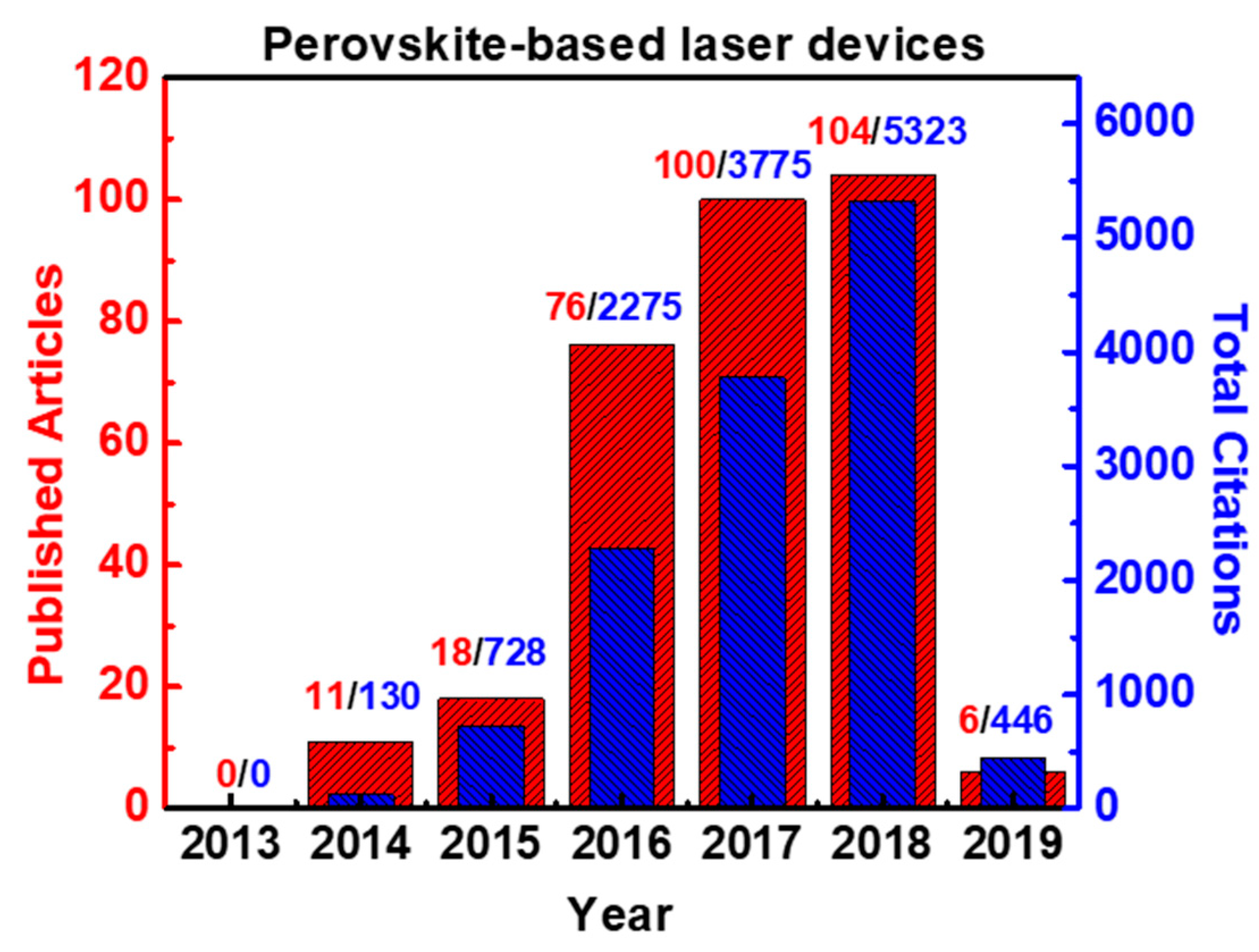
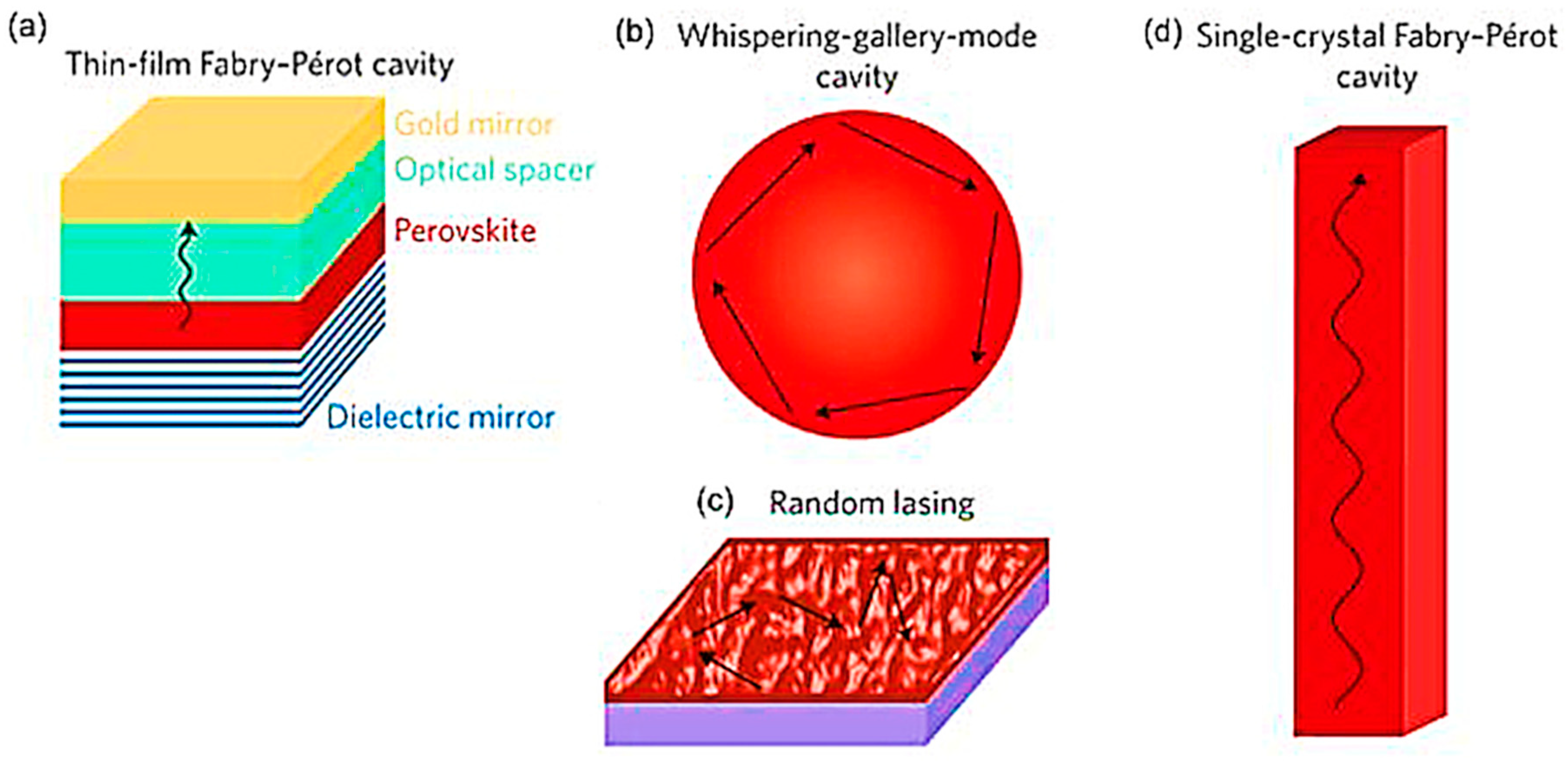
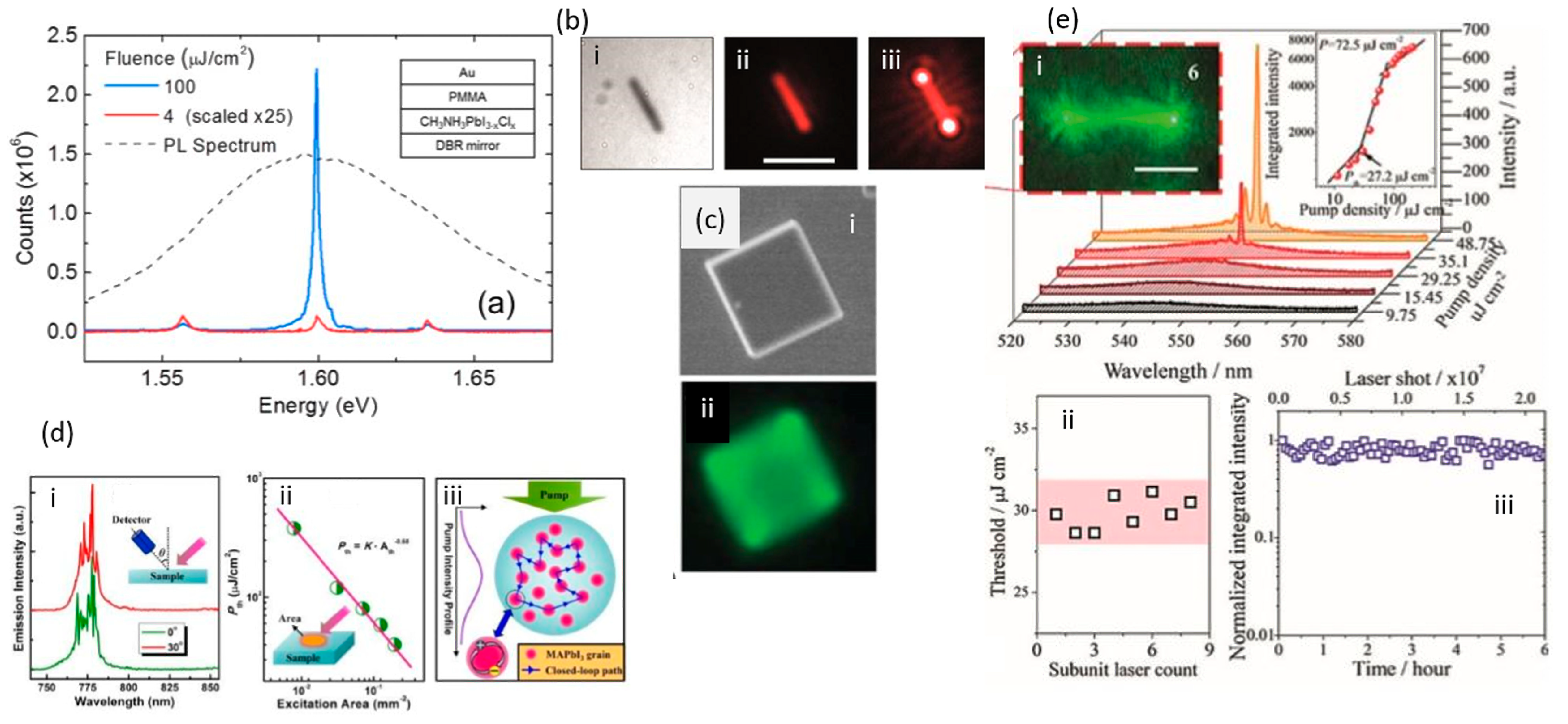
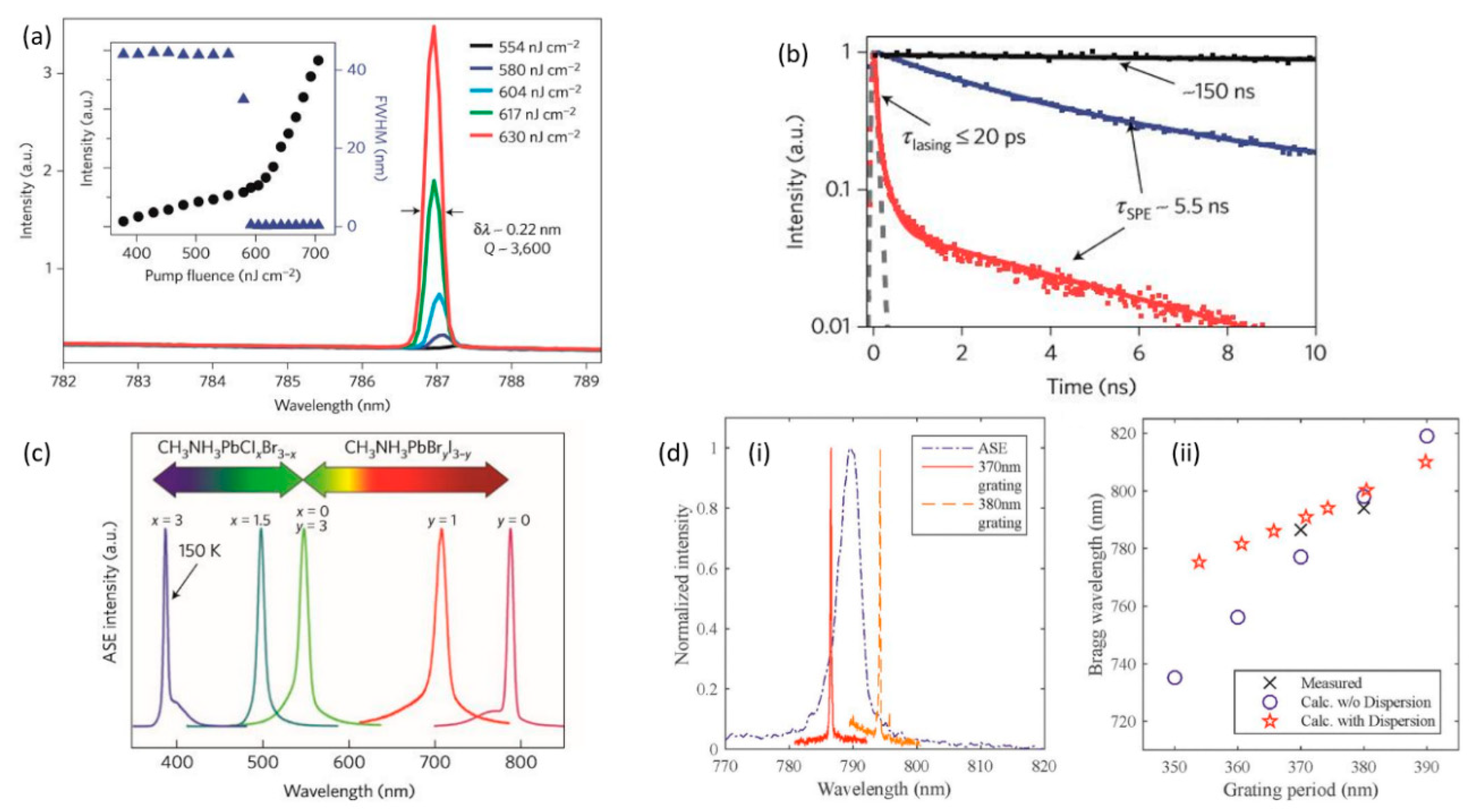
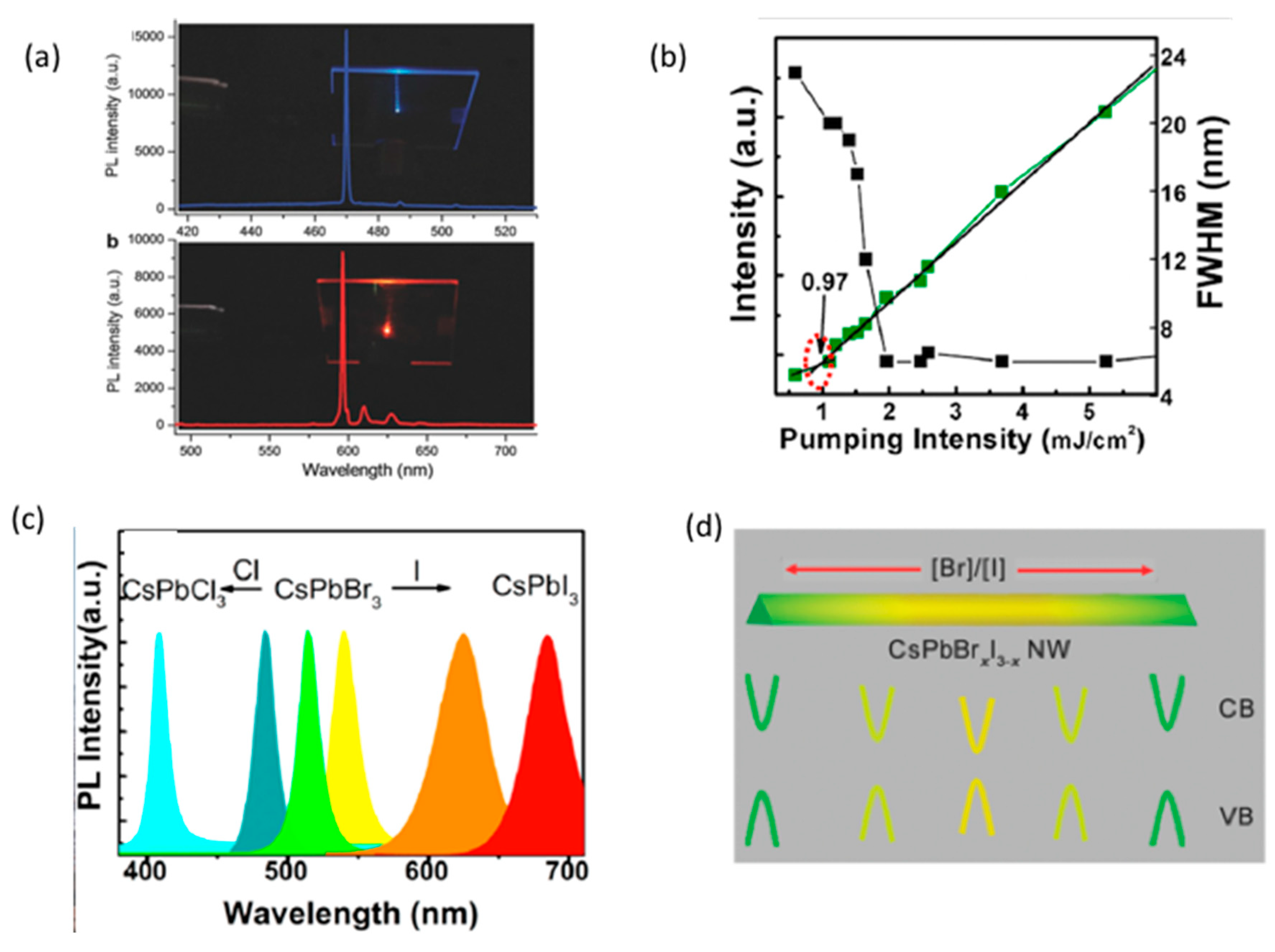
| Material | Nanostructure Type/Cavity Architecture | Laser Threshold (μJ/cm2) | Emission Linewidth (nm) | Emission Wavelength (nm) | Q-Factor | Gain Coefficient (cm−1) | Tunability (nm) | Pumping Source | Reference (Year) |
|---|---|---|---|---|---|---|---|---|---|
| MAPbI3−xClx | Thin Film/Vertical Cavity (FP) | 0.2 μJ/pulse | N/A | 775 | NA | NA | NA | 0.4 ns @ 532 nm | Deschler et al. (2014) [26] |
| MAPbI3 | NWs/Fabry-Perot Cavity | 220 nJ/cm2 | 0.22 | 787 | 3600 | NA | 400–800 | 100 fs @ 402 nm | Zhu et al. (2015) [27] |
| MAPbIBr3 | MDLs/WGM | 3.6 | 1.1 | 557.5 | 430 | NA | 525–557 | 150 fs @ 400 nm | Liao et al. (2015) [28] |
| MAPbI3 | Thin Film/Random lasing | 102 | 0.4 | 775 | NA | NA | NA | 1 ns @ 355 nm | Shi et al. (2016) [29] |
| Ruddlesden—Popper Perovskite | 2D NWs/Fabry-Perot Cavity | 72.5 | 0.3 | 548 | 1800 | 87.3 | NA | @ ~487 nm 1 | Zhang et al. (2018) [30] |
| MAPbI3 | Thin Films/DFB systems | 120 kW/cm2 | 0.2 | 786.5 | NA | NA | 781–794 | 1 ns @ 532 nm | Brenner et al. (2016) [31] |
| MAPbI3 | Photonic Crystal/Fabry-Perot Cavity | 68.5 | 0.24 | 788 | NA | NA | 768–794 | 270 ps @ 532 nm | Chen et al. (2016) [32] |
| MAPbBr3 | MWs/Fabry-Perot Cavity | 674 | 0.8 | 546 | 650 | NA | NA | 100 fs @ 800 nm | Gu et al. (2016) [33] |
| MAPbBr3 | Micro-rods/graphene/Fabry-Perot Cavity | 48 | N/A | 551.8 | N/A | NA | NA | N/A | Zhang et al. (2016) [34] |
| MAPbBr3 | Microplates/WGM | 3.4 | 0.33 | 555 | 1667 | NA | 555–506 | NA | Zhang et al. (2016) [34] |
| MAPbI3 | Platelets/WGM | 11 | N/A | 780 | 1200 | NA | NA | 120 fs @ 400 nm | Liu et al. (2016) [35] |
| (FA, MA)PbI3 and (FA, MA)Pb(I, Br)3 | NWs/Fabry-Perot Cavities | 6.2 | 0.24 | 560 (FAPbBr3) | 2300 | NA | 500–790 | 150 fs @ 400 nm | Fu et al. (2016) [36] |
| CH3NH3 × 3 | Plasmonic NWs/Fabry-Perot Cavities | 13.5 | 5 | 785 | 151 | NA | 767–796 | 120 fs @ 400 nm | Yu et al. (2016) [37] |
| MAPbI3 & MAPbBr3 | Thin Films/Fabry-Perot Cavities | NA | NA | NA | NA | NA | NA | 130 fs or 4 ns 2 | Sarritzu et al. (2016) [38] |
| MAPbBr3 | Nanoribbons/Fabry-Perot Cavities | 4.2 | 0.7 | 553 | NA | NA | NA | 100 fs @ 400 nm | Sun et al. (2017) [39] |
| MAPbX3 | NW arrays/Fabry-Perot Cavities | 18.3 | 0.9 | 543.1 | 500 | NA | NA | 150 fs @ 400 nm | Liu et al. (2017) [40] |
| CH3NH3PbBr3 | Photonic Crystal/DFB (FP) | 1.6 | 0.15 | 545 | NA | NA | NA | 0.5 ns @ 532nm | Shunemann et al. (2017) [41] |
| CH(NH2)2Pb(I1−xBrx)3 | Thin Films/DFB (FP) | 3.5 | NA | 630 | NA | NA | 550–820 | 400 ps @ 532 nm | Cha et al. (2017) [42] |
| CH3NH3PbBr3 | Microsheet/Fabry-Perot Cavities | 0.251 mW | 0.41 | 554 | 1352 | NA | NA | 150 fs @ 325 nm | Chen et al. (2017) [43] |
| CH3NH3PbI3 | Thin Films/DFB (FB) | 17 kW/cm2 | NA | 785 | NA | NA | NA | 920 ns @ 445 nm | Jia et al. (2017) [44] |
| CH3NH3PbI3 | Thin Film/Ring Cavity Laser (FB) | 19.6 | NA | 791.5 | 650 | NA | Possible | 120 fs @ 645nm | Cegielski et al. (2017) [45] |
| CH3NH3PbBr3 | Microplates and Microrods/WGM | 130 | 0.3 | 547 | 1800 | NA | NA | 100 fs @ 1240 nm | Gao et al. (2017) [46] |
| CH3NH3PbX3 | Microplates/WGM | 30 | NA | 770 | 3200 | NA | 550–770 | 100 fs @ 400 nm | Huang et al. (2018) [47] |
| CH3NH3PbBr3 | Thin Film/DFB (FB) | 3.4 | 0.14 | 555 | NA | NA | 543–557 | 0.3 ns @ 532 nm | Pourdavoud et al. (2018) [48] |
| CH3NH3PbI3 | Thin Film/VCSEL(FB) | 12.9 | 0.76 | 782 | 312 | NA | 750–760 | 150 fs @ 633 nm | Wang et al. (2018) [49] |
| CH3NH3PbBr3 | Cube Corner Pyramids/Fabry-Perot Cavities | 75 | 0.56 | 530 | NA | NA | NA | 400 nm | Mi et al. (2018) [51] |
| MAPbI3 | Thin Films/Random lasing | 230 | 3 | 745 | NA | NA | 745–800 3 | 0.5 ns @ 355 nm | Kao et al. (2016) [52] |
| CH3NH3PbBr3 | Thin Film/Random Lasing | 27 mJ/cm2 | NA | 545 | NA | NA | NA | 35 fs @ 1300 nm | Weng et al. (2018) [54] |
| CH3NH3PbI3 | Thin Film/Random Lasing | 10 | 45 | NA | NA | 70.1 | NA | 400 ps @ 532 nm | Safdar et al. (2018) [55] |
| Material | Nanostructure Type/Cavity Architecture | Laser Threshold (μJ/cm2) | Emission Linewidth (nm) | Emission Wavelength (nm) | Q-Factor | Gain Coefficient cm−1 | Tunability (nm) | Pumping Source | Reference (Year) |
|---|---|---|---|---|---|---|---|---|---|
| CsPbX3 | QDs/WGM | 22 | NA | 524.5 | NA | 98 | Possible | 100 fs @ 400 nm | Wang et al. (2015) [57] |
| CsPbX3 | Nanocrystals/FP Cavities and WGM cavities | 5 | 0.15 | 530 | 109 | 450 | 440–700 | 100 fs @ 400 nm | Yakunin et al. (2015) [58] |
| CsPbX3 & MAPb(BrCl)3 | NWs/FP Cavities | 6.2 | 0.26 | 538 | 2069 | NA | 420–710 | 150 fs @ 402 nm | Fu et al. (2016) [59] |
| CsPbX3 | NWs/FP Cavities | 4 | 0.2 | 535 | 2256 | NA | 425–722 | 100 fs @ 400 nm | Wang et al. (2018) [60] |
| CsPbX3 | NWs/FP Cavities | 3 | 0.3 | 530 (of CsPbBr3) | 1300 | NA | NA | 100 fs @ 355 nm | Park et al. (2016) [61] |
| CsPbBrxI3−x | NWs/FP Cavities | 51 | 0.3 | 534 | NA | NA | 521–566 | 150 fs @ 400 nm | Huang et al. (2018) [62] |
| CsPbX3 | Thin Films/VCESL (FP) | 9 | 0.6 | 504 | NA | NA | 400–700 | 100 fs @ 400 nm | Wang et al. (2017) [63] |
| CsPbX3 | Micro-cubes/FP Cavities | 439 | 0.46 | 533 | 1100 | NA | 420–630 | 35 fs @800 nm | Hu et al. (2017) [64] |
| CsPbX3 | Nanocuboids/FP Cavities | 40.2 | 0.29 | 539 | 2075 | 502 | NA | 100 fs @ 400 nm | Liu et al. (2018) [65] |
| CsPbX3 with ZnO NPs | Thin Films/FP Cavities | 569 | NA | 530 | NA | NA | NA | 50 fs @ 800 nm | Li et al. (2017) [66] |
| CsPbBr3 | NWs/FP Cavities | 6 kW/cm2 | NA | 532 | 2300 | NA | NA | 1 W, CW laser diode at 450 nm | Evans et al. (2018) [67] |
| CsPbBrI2-PEO | Thin Films/DFB (FB) | 33 | 4.9 | 654 | NA | 161.1 | NA | 90 ps @ 355 nm | Gong et al. (2017) [68] |
| CsPbX3 | Micro-disc Arrays/WGM | 10.3 | NA | 425 | 530 | NA | 416–530 | 150 fs @ 400 nm | He et al. (2017) [69] |
| CsPbBr3 | QDs/random lasing | 0.97 | 6 | 539 | 90 | NA | 400–700 | 100 fs @ 400 nm | Tang et al. (2016) [70] |
© 2019 by the authors. Licensee MDPI, Basel, Switzerland. This article is an open access article distributed under the terms and conditions of the Creative Commons Attribution (CC BY) license (http://creativecommons.org/licenses/by/4.0/).
Share and Cite
Stylianakis, M.M.; Maksudov, T.; Panagiotopoulos, A.; Kakavelakis, G.; Petridis, K. Inorganic and Hybrid Perovskite Based Laser Devices: A Review. Materials 2019, 12, 859. https://doi.org/10.3390/ma12060859
Stylianakis MM, Maksudov T, Panagiotopoulos A, Kakavelakis G, Petridis K. Inorganic and Hybrid Perovskite Based Laser Devices: A Review. Materials. 2019; 12(6):859. https://doi.org/10.3390/ma12060859
Chicago/Turabian StyleStylianakis, Minas M., Temur Maksudov, Apostolos Panagiotopoulos, George Kakavelakis, and Konstantinos Petridis. 2019. "Inorganic and Hybrid Perovskite Based Laser Devices: A Review" Materials 12, no. 6: 859. https://doi.org/10.3390/ma12060859
APA StyleStylianakis, M. M., Maksudov, T., Panagiotopoulos, A., Kakavelakis, G., & Petridis, K. (2019). Inorganic and Hybrid Perovskite Based Laser Devices: A Review. Materials, 12(6), 859. https://doi.org/10.3390/ma12060859






